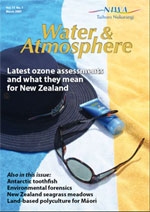PDF of this article (55 KB)

One of NIWA’s aims with this magazine is to contribute to science education in New Zealand. To this end we distribute Water & Atmosphere without charge to New Zealand high schools. Articles are assigned ‘Curriculum Connections’ to indicate which of the NZ NCEA Achievement or Unit Standards they can complement as a classroom resource. These links are assigned by Royal Society of New Zealand Teacher Fellows who are working during the year with NIWA scientists.
The magazine and the Curriculum Connections are also available online at www.niwa.co.nz/pubs/wa/ There you’ll find an archive of back issues beginning with September 2000 (vol. 8, no. 3). All online articles include a pdf of the printed version and the articles are indexed via the website’s search engine. The Curriculum Connections are compiled at www.niwa.co.nz/pubs/wa/resources/
Curriculum connections for this issue
| Pages | Article | Relevant NCEA Achievement Standards (AS) and Unit Standards (US) | Brief summary |
|---|---|---|---|
| 8–9 | Environmental forensics: cracking the case of the contaminated streams | Chemistry Level 3 US6340 Geography Level 1 AS90207, Level 2 AS90336 Science Level 2 US6352, AS90771, Level 3 US6355, US8153 | High levels of PAH contaminants in some urban streams have been traced back to bygone roading material. |
| 10–11 | Tracing the sources of air pollution in New Zealand | Geography Level 1 AS90207, Level 2 AS90336, Level 3 US5097 Science Level 2 US6352, Level 3 US6355 | Two methods for determining the source of air pollution will help local authorities determine where improvements can be made. |
| 12–15 | The 2006 WMO/UNEP Ozone Assessments: what they mean for New Zealand | Geography Level 1 AS90207, Level 2 AS90336, Level 3 AS90706 Science Level 1 US21612, AS90187, Level 2 US6352, AS90771, Level 3 US6355 | The latest assessment shows that the Montreal Protocol is working; meanwhile, our summertime UV intensities will remain high. |
| 16–17 | Comparing seagrass meadows across New Zealand | Biology Level 1 US6294, AS90162, AS90164, Level 2 AS90460 | A nationwide survey looks at the way seagrass meadows function in different areas. |
| 18–19 | Does seagrass contribute to marine biodiversity? | Biology Level 1 US6294, AS90162, Level 2 AS90460 | Seagrass contributes to biodiversity primarily by increasing the range of habitats available for nearshore animals. |
| 20–21 | Finding the role of Antarctic toothfish in the Ross Sea ecosystem | Biology Level 1 US18970, AS90162, Level 2 AS90461, AS90769 Science Level 1 AS90187, Level 2 AS90177 | Modelling the Ross Sea food web will help understand the potential effects of the toothfish fishery. |
| 22–23 | Land-based polyculture for coastal Māori | Biology Level 1 AS90162, US6299, Level 2 US6310 Environmental Tourism Maori Level 3 US17789 Science Level 1 AS90187, US6349, Level 3 US21613 Technology Level 1 US13389, Level 2 US13390 | NIWA is helping Hongoeka Development Trust with a new system that will grow paua as the primary crop. |
| 24–25 | Fish-finding with statistical models | Mathematics Level 2 AS90289, Level 3 AS90641 | Models show where different fish species are likely to live – or to have lived before landscape modification. |
